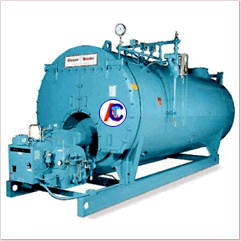Scale build-up in your steam boiler? Learn why scale accumulates, why you should clean it off & how to clean it.
Why Is There Scale On My Boiler?
Calcium carbonate scale is commonly formed in a boiler system by exceeding the threshold solubility of the water’s mineral content. Most dissolved solids in water become soluble as the temperature of the water increases and thus precipitates on heat transfer surfaces as scale. Oftentimes, the temperature of each boiler tube will vary slightly, and more scale tends to develop on these hotter spots. Without proper chemical water treatment in boilers, scale precipitates and can damage your boiler system.
Why Should I Clean The Scale in Boilers?
When scale precipitates and forms within the boiler system, it can cause an isolating effect, which increases temperature variations. These increased variations can result in leaks in a boiler tube, or in extreme cases, boiler tube rupture. Another effect of scale formation is seen in heat transfer efficiency. The scale in boilers will decrease efficiency and typically result in higher fuel and energy bills.
How Do I Clean The Scale Off Of The Boiler?
Below is a step-by-step procedure on how to best clean steam boiler waterside deposits. Additional products and steps will be required if you suspect that the majority of the scale is not calcium carbonate. Also, note that it is rare that the entire boiler surface is completely clean after acid cleaning. It is difficult to get enough circulation and velocity to all parts of the boiler to remove all the scale. This procedure may need to be repeated several times if the severity of the scale is substantial. Lastly, the acid used for this cleaning is hydrochloric acid which produces fumes with normal use. Be sure to have adequate ventilation to the outside when using this product.
Learn More About Our Boiler Treatment Services
Procedure to Clean Scale From Your Steam Boiler
Follow this procedure to clean scale from your steam boiler:
- Isolate the boiler by closing the gate valves as close to the vessel as possible. Keep the top manhole open to allow for periodic inspections during the cleaning.
- Estimate the total number of gallons of water the vessel section will contain. Calculate the amount of initial acid to use to get a 1-5% concentration of Chardon’s Scalzo in the boiler. Use only Scalzo to prevent excessive steel corrosion while the cleaning is taking place.
- Fill the boiler to capacity with water. Immediately add the Scalzo followed by a small amount of Chardon’s CTA-800 (4 oz per 1000 gallons). Check pH before starting the boiler knowing it has not mixed in well just yet. pH should be between 1-3.
- Promptly have the boiler operator operate the boiler to heat the cleaning solution in the boiler to a maximum of 130 F. DO NOT BOIL THE WATER. Be sure to check the temperature since above the temperature causes excessive corrosion of the steel by the chlorides in the cleaning solution. Generally, when the water just starts to move inside the boiler, it is at the correct temperature. The velocity of the water inside the boiler aids in dispersing the dissolved calcium and provides contact of scale with fresh acid to continue cleaning. If an air lance is available, use it to provide an air-bubbling action at the bottom of the boiler vessel which encourages circulation.
- Continue turning on and off the boiler to maintain the temperature in the range of 100-130F. Check pH every 15 minutes; (should be 1 or 2). If higher, add Scalzo to depress the pH back to 1-2 pH.
- Continue step 5 until pH remains at 1 or 2 for 120 minutes or more, depending on scale build-up. The system is then as clean as will be with the current cleaning solution. Neutralize the cleaning solution to a pH of 5.0 with Chardon’s BD-6 by adding it to the vessel and circulating the mixture for a few minutes. Check pH – add more BD-6 if needed and circulate if necessary. Drain the solution from the boiler as quickly as possible.
- Add water to the vessel and continue rinsing the boiler internals. Drain again and inspect for the level of cleaning success. If further cleaning is desired, repeat the cleaning process with fresh Scalzo.
- If cleaning is successful, immediately refill the boiler with water and add chemicals to get pH to 11 and sulfite to 200 ppm. Replace the manhole and have the operator re-fire the boiler and bring it to normal operating temperature.

Matt Welsh
Matt Welsh is the Vice President and Water Consultant at Chardon Labs. He helps consult a wide range of customers utilizing various methods of water treatment, from chemical to chemical-free approaches, large and small applications, and across a wide range of geographical influences. With 20 years of water treatment experience, including a wide range of troubleshooting and service in potable water and non-potable HVAC and industrial applications, he is an expert in water treatment chemistry for cooling towers, boilers, and closed-loop systems.

